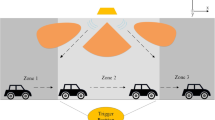Abstract
Cellular phone antennas are generally designed to have radiation patterns that are as omnidirectional as possible. Omnidirectional antennas allow a phone’s radio to work well for many orientations of the phone with respect to the cellular base station. Recent studies, however, are generating uncertainty about the health effects of prolonged exposure to electromagnetic (EM) radiation from cellular phones. In this paper, an antenna array is designed primarily to minimize users’ exposure to EM radiation. The antenna comprises a beamforming 4 by 3 array of microstrip patch antennas that is controlled by an accelerometer-only inertial navigation system. The proposed design reduces radiated power directed toward the user to below 10% of the total in the worst case.

















Similar content being viewed by others
References
Vecchia, P., Matthes, R., Ziegelberger, G., Lin, J., Saunders, R., & Swerdlow, A. (2009). Exposure to high frequency electromagnetic fields, biological effects and health consequences. Madrid: International Commission On Non-Ionizing Radiation Protection.
Coureau, G., Bouvier, G., Lebailly, P., et al. (2014). Mobile phone use and brain tumours in the CERENAT case-control study. Occupational and Environmental Medicine, 71(7), 514–522.
Hardell, L., Carlberg, M., & Hansson, M. K. (2011). Pooled analysis of case-control studies on malignant brain tumours and the use of mobile and cordless phones including living and deceased subjects. International Journal of Oncology, 38(5), 1465–1474.
Deltour, I., Auvinen, A., Feychting, M., et al. (2012). Mobile phone use and incidence of glioma in the Nordic countries 1979–2008: Consistency check. Epidemiology, 23(2), 301–307.
Little, M. P., Rajaraman, P., Curtis, R. E., et al. (2012). Mobile phone use and glioma risk: Comparison of epidemiological study results with incidence trends in the United States. British Medical Journal, 344, e1147.
Gruenwald, W. (2009). Design of a smart antenna for cellular phones for minimal radiation absorption by the human brain/body. MS Thesis, University of Applied Sciences Offenburg, Germany.
King, A. D. (1998). Inertial navigation—forty years of evolution. GEC Review, 13(3), 140–149.
Tan, C., & Park, S. (2005). Design of accelerometer-based inertial navigation systems. IEEE Transactions on Instrumentation and Measurement, 54(6), 2520–2530.
Hibbeler, R. C. (1998). Engineering mechanics dynamics (8th ed.). Upper Saddle River: Prentice-Hall.
Schmidt, P. (2010). Inertial control of a beamforming antenna array for use in cellular phones. Corvallis, OR: Oregon State University.
Balanis, C. A. (1997). Antenna theory—Analysis and design (2nd ed.). New York: Wiley.
Serway, R. A., Beichner, R. J., & Jewett, J. W., Jr. (2000). Physics for scientists and engineers (5th ed.). Forth Worth: Saunders College Publishing.
Sotoudeh, O. (2008). Electromagnetic simulation of mobile phone antenna performance. Microwave Journal, 51(1), 78–92.
Author information
Authors and Affiliations
Corresponding author
Rights and permissions
About this article
Cite this article
Schmidt, P.L., Grünwald, W., Magaña, M.E. et al. Beam Forming and Steering with INS for Cellular Phones to Reduce EM Radiation Exposure. Wireless Pers Commun 97, 19–39 (2017). https://doi.org/10.1007/s11277-017-4490-y
Published:
Issue Date:
DOI: https://doi.org/10.1007/s11277-017-4490-y




